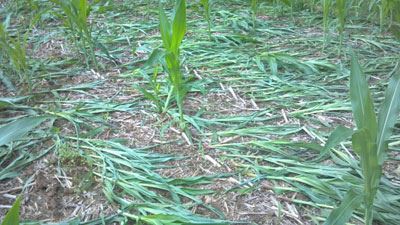Specialist Finds Leaning And Greensnapped Corn And Flooding
DR. ANGELA MCCLURE
JACKSON, TENN.
Have been checking fields this week for stalk issues in corn, especially after the high winds that occurred here lately. Fortunately many fields look fine and corn is standing well. In other areas at least some corn did sustain wind damage causing leaning or snapped stems. Leaning corn is the best of the two scenarios. If corn seed is planted deep enough and roots are pretty well anchored, young leaning corn will often right itself and continue on to produce a normal ear in the coming weeks. Greensnapped corn is the result of pressure (wind or equipment) being applied to a brittle stalk. Some hybrids are more prone to brittle stalks when the plants are growing rapidly under high moisture conditions. Growth regulator applications can also create a tendancy to brittleness as well. Unfortunately greensnap in older plants means we have lost those plants since the growing point is typically above the break line. In plants younger than V-6, the growing point may be below the break and the plant will put out leaves and make an attempt to create a new, albeit shorter, corn plant. Scout fields for damaged areas and contact your crop insurance agent if large areas are discovered.

Greensnapped corn at Milan REC; June 4, 2014
With rain still in our forecast, we may end up with some flooded corn in low lying areas. Floodwaters cause plant damage when water stands over the corn for longer than a day at our current warm air temperatures. Where water recedes quickly, corn is usually not affected. There is always the risk that downy mildew deposited with silt in the whorl will affect tassel and leaf development, but we cannot know if plants are infected until later in the season. My experience is the more times water goes over the corn you increase the risk of ‘crazy top’ later in the season. Not all plants will be affected. Last year, one of my large strip trials went under water at least 2 times early season, and about 25 percent of the plants ended up crazy topped at the end of the year. This particular field had a history of crazy top in previous corn crops. There are no known treatments to prevent crazy top in infected corn. In our trial, we had applied foliar fungicide both early and/or at tassel, and did not see a reduction in crazy top due to fungicide treatment. ∆
DR. ANGELA MCCLURE: Extension Corn and Soybean Specialist, University of Tennessee